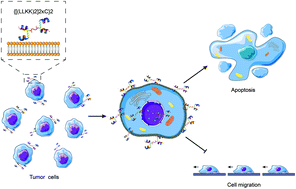Branched α-helical peptides enhanced antitumor efficacy and selectivity†
Abstract
Drug resistance to traditional chemotherapeutics is one of the main challenges in cancer treatment. Herein, cationic antimicrobial peptides (CAPs) were repurposed as anticancer agents to counter chemotherapy drug resistance. After a systematic study of de novo designed synthetic α-helical CAPs in various cell lines, the 4-arm branched peptide {[(LLKK)2]2κC}2 was found to exhibit better selectivity compared to its linear counterpart (LLKK)4, and was more effective than the 2-arm branched peptide [(LLKK)2]2κC. In particular, the 4-arm branched peptide could counter drug resistance and kill multiple drug resistant cells. Mechanism studies reveal that these α-helical peptides killed both the parent and resistant cancer cells based on the apoptotic pathway. The in vivo study in mice bearing breast tumors showed that branched peptides could be retained at the tumour sites after intratumoral injection and significantly reduced tumor growth while exhibiting minimal toxicity on main organs. These results indicate that the 4-arm branched peptide is a promising candidate for anticancer therapy.



 Please wait while we load your content...
Please wait while we load your content...